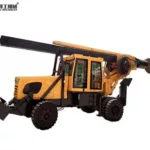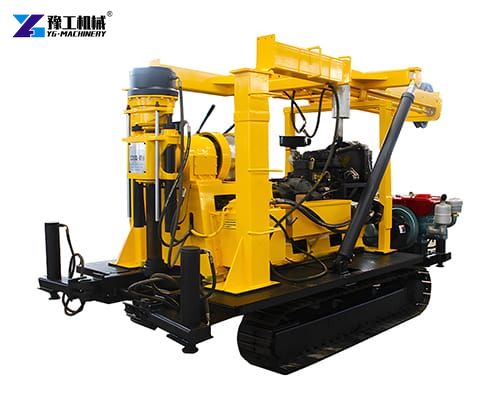RC drilling machine, reverse circulation drilling rig, is a powerful drilling rig that utilizes a dual-wall drill rod system to circulate compressed air or fluid in a reverse direction. Reverse circulation drilling is a specialized method designed to retrieve high-quality subsurface samples with minimal contamination. Different from traditional drilling methods that push cuttings to the surface, RC drilling employs a vacuum-like effect to transport rock fragments back to the surface through the inner tube of the drill rod. This process minimizes sample contamination and maximizes recovery rates, making it ideal for mineral exploration and geotechnical investigations.
Components of an RC Drilling Machine
Drill Rig: The primary structure housing the power source, mast, and rotational mechanism.
Compressor: Supplies high-pressure air to power the drilling process.
Dual-Wall Drill Rods: Consist of an outer tube for air circulation and an inner tube for sample retrieval.
Hammer Assembly: A pneumatic or hydraulic hammer that delivers percussive force to the drill bit.
Cyclone Separator: Separates air from rock cuttings at the surface.
Advantages Of Reverse Circulation Drilling Machine
The popularity of RC drilling machine stems from their unique benefits across diverse applications:
Versatility
These machines excel in various terrains, from arid deserts to rocky highlands. They can drill to depths exceeding 500 meters, catering to both shallow and deep exploration needs.
Superior Sample Quality
By minimizing contamination and oxidation, RC drilling delivers pristine samples. This is critical for accurate mineral assays and geological assessments.
High Penetration Rates
The combination of pneumatic hammers and dual-wall pipes enables faster drilling. Projects are completed in shorter timeframes, reducing costs.
Applications Of RC Drilling Technology
- Mineral Exploration
Reverse circulation drilling machine is the gold standard for mineral prospecting. Its ability to provide uncontaminated samples ensures reliable data for resource estimation, guiding investment decisions in mining projects. - Geotechnical Investigations
Engineers use RC drilling to assess soil stability, rock strength, and groundwater conditions. This information is vital for infrastructure projects like dams, tunnels, and foundations. - Water Well Drilling
In remote areas, RC drilling machine drill high-yield water wells efficiently. Their mobility allows access to underserved regions, supporting community development. - Environmental Monitoring
RC technology aids in installing groundwater monitoring wells and collecting soil samples for contamination studies. Its precision helps track pollutants and design remediation strategies. - Blast Hole Drilling
In mining operations, RC drills create blast holes for controlled explosions. Their speed and accuracy improve safety and productivity in open-pit mines.
Maintenance And Operational Best Practices
To maximize the lifespan and efficiency of an RC drilling machine, adhere to these guidelines:
- Regular Inspections
Check drill pipes, hammers, and compressors for wear. Replace damaged components promptly to avoid downtime. - Lubrication Management
Properly lubricate moving parts to reduce friction and prevent overheating. - Operator Training
Skilled operators minimize equipment misuse. Provide training on safe handling, troubleshooting, and emergency protocols.




